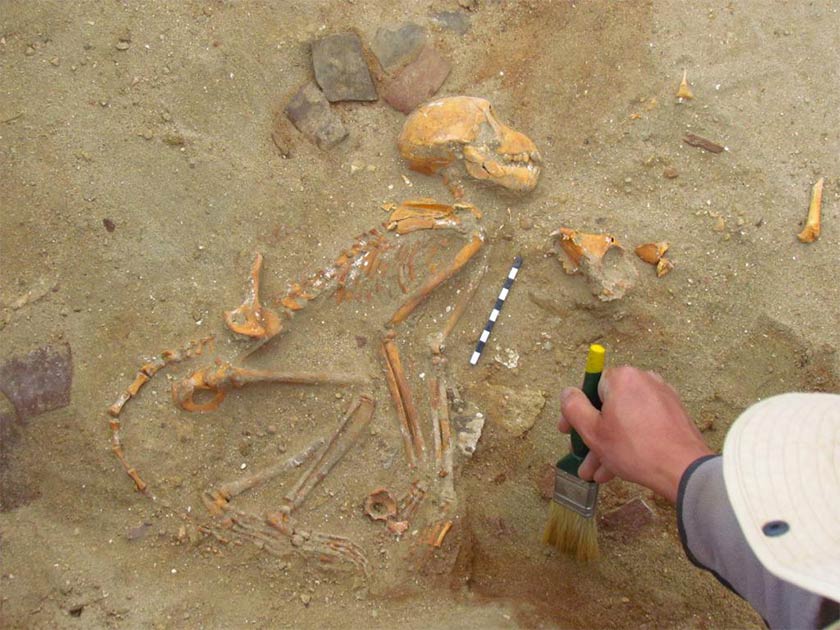Pet Monkeys Buried Like Children In Ancient Egypt
Polish archaeologists have uncovered several skeletons of monkeys that were pets of ancient Greeks and Romans who lived in Egypt in the first and second century AD. The remains of these pet monkeys were buried with great care. What is even more remarkable is that these pet monkeys were imported from India, which is providing experts with new evidence on the extent of Roman and Greek trade networks.
The buried pet monkeys were found by archaeologists from the University of Warsaw at an animal cemetery in the ancient port of Berenice, on Egypt’s Red Sea coast. They were working at the site when they came across a number of skeletons of primates dating from Roman rule in the region. “For years they assumed they belonged to guenon species, quite common in this area” according to First News.
However, experts could not immediately identify the specimens. When specialists re-examined, the remains using scanners and compared their findings with monkey species from Africa and elsewhere they made an amazing discovery.

A closeup of one of the Indian pet monkey skeletons. (Marta Osypińska / Science in Poland)
Indian Pet Monkeys Were Status Symbols in Roman Egypt
Researchers determined that the remains of the monkeys they found were originally from India. Professor Marta Osypińska, a zooarchaeologist who participated in the project, told First News that “This is a unique finding. Until now, no one has found Indian monkeys in the archaeological sites in Africa. Interestingly, even ancient written sources don’t mention this practice.” The ancient port of Berenice, where the discovery was made, was well-known for its extensive trade relations with kingdoms in India.
The port dates back to the times of the pharaohs when it traded with African outposts. It was only in the Ptolemaic period (305 to 30 BC) that the port began to trade with India. Trade with India was initiated because the Ptolemies needed war elephants, which they used in their endless battles with the Seleucid Empire. Trade between Egypt and India later expanded to spices, textiles and gold, generating immense profits.
Pets And Trade In The Ancient Egyptian World
The Romans greatly expanded the port of Berenice during the reign of Augustus. There were annual trade missions from the port to India. Rome had an insatiable appetite for luxury goods and products. This trade helped to make Roman Egypt very prosperous and the taxes it generated were crucial for Rome. However, over time, the silver and gold that the Romans used to purchase Indian goods declined causing serious financial implications which some say led to the decline of the Roman Empire.
Prof. Osypińskia is quoted by the Daily Express as saying that “We knew spices, textiles and other riches were imported from India. It turns out, monkeys were as well.” This raised the question of why they imported exotic animals, which would have been very expensive. The expert told First News that “We believe that the influential Romans who lived in Berenice, a faraway outpost, in the first and second, wanted to make their time pleasant with the company of various animals. Among them were also monkeys.”

One of the discovered pet monkeys recently discovered: “sleeping like a baby” with hands placed near its head. (Marta Osypińska / Science in Poland)
Evidence Reveals Just How Much These Pet Monkeys Were Loved
The distinctive Indian pet monkeys would have been an extremely rare possession in Egypt and therefore also a status symbol. Evidence uncovered at the Berenice animal cemetery shows that they were much-loved pets. According to the Daily Express “Some of the pet monkeys, in particular, were laid to rest with their hands by their heads, like sleeping children.” One of the buried monkey pets was found covered with a woolen blanket, while another buried with large shells that would have been valuable in the first and second century AD.
The transportation of pet monkeys from India would have been expensive. Professor Osypińska, is quoted by First News as saying that “It involved providing the animals with adequate food and water during a few weeks' cruise across the Indian Ocean and the Red Sea.” While the monkeys may have been popular pets they did not live long. Perhaps, they didn’t receive enough proper “monkey” food or were unable to adapt to the climate of Egypt or simply died earlier due to stress.
- Primates of Ancient Egypt: The Deification and Importance of Baboons and Monkeys—Part I
- Silk Road Cat Pushes Back Central Asia Domestication to 8th-century AD
This research by Polish researchers has provided many new insights into Roman trade with India and, also, into the lifestyles of people in the area during the first and second century AD. From the evidence found so far, we can clearly understand that these people loved to have rare and unusual animals as pets and that they became attached to them. In this regard, our ancient ancestors seemed to have adored exotic pets as much as we do today.
Top image: The full skeleton of one of the Indian pet monkeys found by Polish researchers in a pet cemetery in the ancient port of Berenice, Egypt. Source: Marta Osypińska / Science in Poland
By Ed Whelan



















